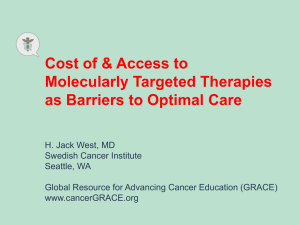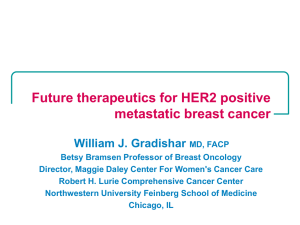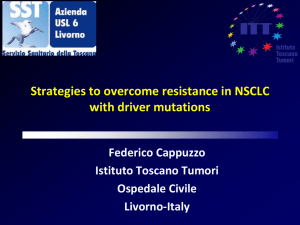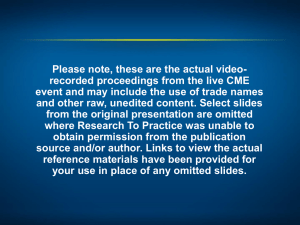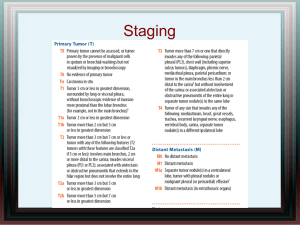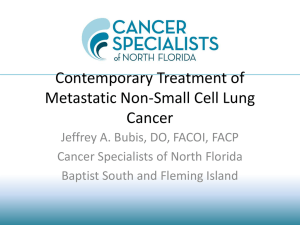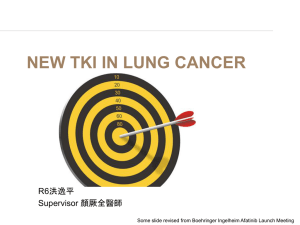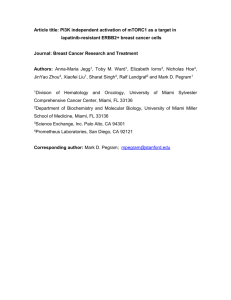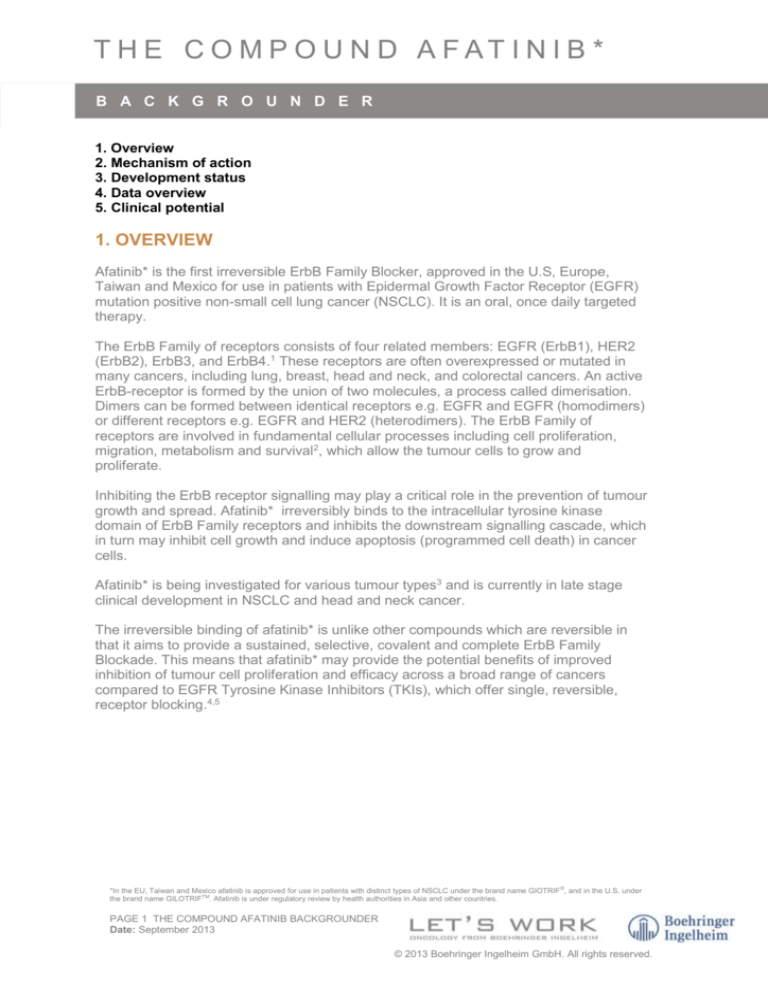
T H E C O M P O U N D A FAT I N I B *
B A C K G R O U N D E R
1. Overview
2. Mechanism of action
3. Development status
4. Data overview
5. Clinical potential
1. OVERVIEW
Afatinib* is the first irreversible ErbB Family Blocker, approved in the U.S, Europe,
Taiwan and Mexico for use in patients with Epidermal Growth Factor Receptor (EGFR)
mutation positive non-small cell lung cancer (NSCLC). It is an oral, once daily targeted
therapy.
The ErbB Family of receptors consists of four related members: EGFR (ErbB1), HER2
(ErbB2), ErbB3, and ErbB4.1 These receptors are often overexpressed or mutated in
many cancers, including lung, breast, head and neck, and colorectal cancers. An active
ErbB-receptor is formed by the union of two molecules, a process called dimerisation.
Dimers can be formed between identical receptors e.g. EGFR and EGFR (homodimers)
or different receptors e.g. EGFR and HER2 (heterodimers). The ErbB Family of
receptors are involved in fundamental cellular processes including cell proliferation,
migration, metabolism and survival2, which allow the tumour cells to grow and
proliferate.
Inhibiting the ErbB receptor signalling may play a critical role in the prevention of tumour
growth and spread. Afatinib* irreversibly binds to the intracellular tyrosine kinase
domain of ErbB Family receptors and inhibits the downstream signalling cascade, which
in turn may inhibit cell growth and induce apoptosis (programmed cell death) in cancer
cells.
Afatinib* is being investigated for various tumour types3 and is currently in late stage
clinical development in NSCLC and head and neck cancer.
The irreversible binding of afatinib* is unlike other compounds which are reversible in
that it aims to provide a sustained, selective, covalent and complete ErbB Family
Blockade. This means that afatinib* may provide the potential benefits of improved
inhibition of tumour cell proliferation and efficacy across a broad range of cancers
compared to EGFR Tyrosine Kinase Inhibitors (TKIs), which offer single, reversible,
receptor blocking.4,5
*In the EU, Taiwan and Mexico afatinib is approved for use in patients with distinct types of NSCLC under the brand name GIOTRIF ®, and in the U.S. under
the brand name GILOTRIFTM. Afatinib is under regulatory review by health authorities in Asia and other countries.
PAGE 1 THE COMPOUND AFATINIB BACKGROUNDER
Date: September 2013
© 2013 Boehringer Ingelheim GmbH. All rights reserved.
T H E C O M P O U N D A FAT I N I B *
B A C K G R O U N D E R
Source: Hynes NE, et al. Nat Rev Cancer 2005;5:341-54.
2. MECHANISM OF ACTION
Afatinib*, an irreversible ErbB Family Blocker, inhibits signal transduction and blocks key
pathways involved in cell growth and division. Since ErbB Family signalling can be
initiated by a variety of homo- and heterodimers, a combined inhibition of more than one
ErbB Family member may provide a more successful blockade of ErbB Family
signalling.4
Afatinib’s* unique mechanism of action, which may provide a more complete blockade of
pathways that help tumour cells grow, migrate and metabolise, could potentially lead to
a greater overall effect on the tumour.
The ErbB Family is frequently dysregulated in cancer cells; overexpression of ErbB
receptors can lead to the development of a variety of solid tumours.6 Over-activation of
these receptors triggers intracellular signalling cascades that ultimately cause
uncontrolled tumour cell proliferation, migration and metastasis, and inhibition of
apoptosis.6 There are a variety of mechanisms leading to constitutive activation of this
signal-transduction pathway,7 including receptor mutation (e.g. EGFR mutation in lung
cancer), receptor overexpression (e.g. HER2 overexpression in breast cancer) or ligand
overexpression.7
3. DEVELOPMENT STATUS IN LUNG CANCER
The LUX-Lung clinical trial programme is investigating afatinib* in a number of patient
populations with advanced NSCLC. Two pivotal Phase III studies, LUX-Lung 3 (n=345)
and LUX-Lung 6 (n=364) represent the largest, most robust and consistent clinical
registration trial programme in EGFR mutation positive NSCLC to date. In 2013, the
results from LUX-Lung 3 were published in the Journal of Clinical Oncology8,9 and those
from LUX-Lung 6 were presented at the American Society of Clinical Oncology Annual
Meeting.10,11
*In the EU, Taiwan and Mexico afatinib is approved for use in patients with distinct types of NSCLC under the brand name GIOTRIF ®, and in the U.S. under
the brand name GILOTRIFTM. Afatinib is under regulatory review by health authorities in Asia and other countries.
PAGE 2 THE COMPOUND AFATINIB BACKGROUNDER
Date: September 2013
© 2013 Boehringer Ingelheim GmbH. All rights reserved.
T H E C O M P O U N D A FAT I N I B *
B A C K G R O U N D E R
As part of the LUX-Lung clinical trial programme, there are currently eight studies
designed to investigate the use of afatinib* in various settings of advanced NSCLC,
including in patients who have EGFR mutations and those with recurrent disease. These
trials include:
LUX-Lung 1, a Phase IIb/III trial investigating afatinib* plus best supportive care
(BSC) versus placebo plus BSC in NSCLC patients who were previously treated
with first-line chemotherapy and the reversible EGFR tyrosine kinase inhibitors
(TKIs) erlotinib or gefitinib. (Status: Completed, published)
LUX-Lung 2, a Phase II trial evaluating afatinib* in NSCLC patients with EGFR
mutations, either treatment-naïve or after one line of treatment with
chemotherapy. (Status: Published)
LUX-Lung 3, a Phase III trial investigating afatinib* as a first-line treatment in
patients with advanced NSCLC with EGFR mutations. (Status: Ongoing,
published)
LUX-Lung 4, a Phase I/II trial investigating afatinib* in NSCLC patients who have
progressed after EGFR-TKI treatment. (Status: Completed, published)
LUX-Lung 5, a Phase III trial investigating afatinib* plus paclitaxel versus
investigator’s choice of chemotherapy after progressing on afatinib* monotherapy
in patients with advanced NSCLC previously treated with erlotinib or gefitinib.
(Status: Ongoing, no longer recruiting)
LUX-Lung 6, a Phase III trial investigating the efficacy and safety of afatinib*
compared to standard chemotherapy for first-line treatment of NSCLC patients
with EGFR mutations. (Status: Ongoing, reported).
LUX-Lung 7, a Phase IIb trial evaluating afatinib* head-to-head versus gefitinib
as a first-line treatment in patients with advanced NSCLC with EGFR mutations.
(Status: ongoing, no longer recruiting)
LUX-Lung 8, a Phase III trial evaluating afatinib* head-to-head versus erlotinib in
second-line treatment of squamous cell carcinoma of the lung. (Status:
recruiting)
4. DATA OVERVIEW
Efficacy and Safety Profile
LUX-Lung 3 and LUX-Lung 6 are multicentre, randomised, open-label, Phase III trials of
afatinib* versus chemotherapy (pemetrexed/cisplatin and gemcitabine/cisplatin
respectively) as first-line treatment for patients with advanced and metastatic NSCLC
harbouring an EGFR mutation.8,10
These pivotal Phase III trials showcase the growing evidence of the superiority of
afatinib* over standard of care chemotherapies (pemetrexed/cisplatin and
gemcitabine/cisplatin respectively). The consistent results from both these studies
substantiate the robust efficacy and safety profile of afatinib*, therefore reinforcing
confidence in the data.
*In the EU, Taiwan and Mexico afatinib is approved for use in patients with distinct types of NSCLC under the brand name GIOTRIF ®, and in the U.S. under
the brand name GILOTRIFTM. Afatinib is under regulatory review by health authorities in Asia and other countries.
PAGE 3 THE COMPOUND AFATINIB BACKGROUNDER
Date: September 2013
© 2013 Boehringer Ingelheim GmbH. All rights reserved.
T H E C O M P O U N D A FAT I N I B *
B A C K G R O U N D E R
LUX-Lung 310,12
(Afatinib* vs pemetrexed/cisplatin)
LUX-Lung 611,13
(Afatinib* vs gemcitabine/cisplatin)
Progression Free Survival8,10 (PFS – time patient is alive without their tumour starting to grow)
11.1 months vs 6.9 months for all patients
(n=345) with EGFR mutations by independent
review
13.6 months vs 6.9 months for a subgroup of
patients (n=308) with the most common
mutations (~90% of all patients, del19 and
L858R) by independent review
11.0 months vs 5.6 months for all patients
with EGFR mutations by independent review
Based on investigator review patients lived
for well over a year before their tumour started
to grow again, versus just under half a year for
those on standard chemotherapy (PFS of 13.7
months vs 5.6 months)
In addition, 47% of afatinib-treated patients
are alive and progression-free after 1 year
of treatment compared to only 2% on
chemotherapy
The delay in tumour growth compares well in both registration trials, substantiating the efficacy of
afatinib and the robustness of the data
Objective Response9,10 (Tumour Shrinkage)
One in two patients (56%) taking afatinib
experienced tumour shrinkage compared
to one in four (23%) in the chemotherapy
arm, by independent review
In 67% of patients taking afatinib the
tumour shrunk significantly in size
compared to 23% in the chemotherapy arm,
by independent review
Tumour shrinkage translated into improvements in disease-related symptoms
Disease Related Symptoms8,11
More patients across both studies taking afatinib experienced improvement of symptoms such as
dyspnoea (shortness of breath), cough and chest pain. Afatinib treatment also delayed the onset
of these symptoms
Quality of Life (Measured by patient questionnaires)8,11
Consistent with findings in both trials, afatinib patients in LUX-Lung 6 and LUX-Lung 3 reported to
have a significantly better quality of life (for example, at work and during household activities) than
those on chemotherapy
Grade ≥3 Adverse Events (AEs)9,10
The most common drug-related adverse events
observed in the afatinib treatment arm were
diarrhoea, rash and paronychia
The most common drug-related adverse events
observed in the chemotherapy arm were
nausea/vomiting, decreased appetite, and
fatigue
There was a low discontinuation rate
associated with treatment-related adverse
events in the trial (8% discontinuation rate for
afatinib; 12% for chemotherapy)
1% of patients in the afatinib arm
discontinued treatment due to diarrhoea
The most common adverse events associated
with afatinib were diarrhoea, rash/acne and
stomatitis/mucositis (inflammation of mouth and
throat)
The most common AEs associated with
chemotherapy were neutropenia (an abnormally
low level of neutrophils, a type of white blood
cell), vomiting and leukopenia (a decrease in
the number of white blood cells)
The discontinuation rate due to AEs was 6% of
patients on the afatinib arm and 40% of patients
on the chemotherapy arm
Patients rarely decided to discontinue afatinib
treatment due to adverse events. Specifically
only 2% discontinued due to rash/acne and
none for diarrhoea
*In the EU, Taiwan and Mexico afatinib is approved for use in patients with distinct types of NSCLC under the brand name GIOTRIF ®, and in the U.S. under
the brand name GILOTRIFTM. Afatinib is under regulatory review by health authorities in Asia and other countries.
PAGE 4 THE COMPOUND AFATINIB BACKGROUNDER
Date: September 2013
© 2013 Boehringer Ingelheim GmbH. All rights reserved.
T H E C O M P O U N D A FAT I N I B *
B A C K G R O U N D E R
Tolerability
The side effects of afatinib* are predictable, generally manageable and reversible. In
studies to date, drug-related adverse events were largely related to the gastrointestinal
tract (diarrhoea) and skin disorders (rash), which is in line with EGFR tyrosine-kinase
inhibition.12-17
5. CLINICAL POTENTIAL
Signal transduction inhibitors are a key development target in cancer research. The
irreversible binding properties of afatinib* and its selective and irreversible ErbB Family
Blockade may provide benefits of improved inhibition and may broaden potential
indications in many cancers.
At this stage of development, results have indicated that afatinib* may have potential
benefits compared to other signal transduction inhibitors, with a comparable tolerability
profile (40 mg dose). The ongoing study programme evaluating afatinib* in a number of
indications will provide more clinical data to further establish the benefits of this
compound demonstrated in earlier studies.
REFERENCES
1.
2.
3.
4.
5.
6.
7.
8.
9.
10.
11.
12.
13.
14.
Hynes NE, Lane HA. ERBB receptors and cancer: the complexity of targeted inhibitors. Nat Rev Cancer
2005;5:341-54.
Hynes NE, MacDonald G. ErbB receptors and signalling pathways in cancer. Curr Opin Cell Biol 2009; 21:17784.
Li D, Ambrogio L, Shimamura T, et al. BIBW2992, an irreversible EGFR/HER2 inhibitor highly effective in
preclinical lung cancer models. Oncogene 27:4702-11.
Reid A, Vidal L, Shaw H, do Bono J.Dual inhibition of ErbB1 (EGFR/HER1) and ErbB2 (HER2/neu). Eur J
Cancer 2007;43:481-9.
Solca F, Dahl G, Zoephel A, et al. Target binding properties and cellular activity of afatinib (BIBW 2992), an
irreversible ErbB family blocker. J Pharmacol Exp Ther 2012;343:342-50.
Hanahan D, Weinberg RA. The Hallmarks of Cancer. Cell,100(1), pp.57-70.
Wieduwilt MJ, Moasser MM. The epidermal growth factor receptor family: biology driving targeted therapeutics.
Cell Mol Life Sci 2008;65:1566-84.
Yang J, Hirsh V, Schuler M, et al. Symptom Control and Quality of Life in LUX-Lung 3: A Phase III Study of
Afatinib or Cisplatin/Pemetrexed in Patients With Advanced Lung Adenocarcinoma With Epidermal Growth
Factor Receptor Mutations. J Clin Oncol 2013;DOI: 10.1200/JCO.2012.46.1764
Sequist L, Yang J, Yamamoto N, et al. Phase III Study of Aaftinib or Cisplatin Plus Pemetrexed in Patients With
Metastatic Lung Adenocarcinoma With Epidermal Growth Factor Receptor Mutations. J Clin Oncol 2013;DOI:
10.1200/JCO.2012.44.2806
Wu, Y., MD. LUX-Lung 6: A randomized, open-label, Phase III study of afatinib (A) vs. gemcitabine/cisplatin
(GC) as first-line treatment for Asian patients (pts.) with EGFR mutation-positive (EGFR M+) advanced
adenocarcinoma of the lung. (Abstract #8016) at American Society of Clinical Oncology, Chicago, June 2,
2013.
Geater, SL, MD. LUX-Lung 6: Patient reported outcomes (PROs) from a randomized open-label, Phase III
study in 1st-line advanced NSCLC patients (pts.) harbouring epidermal growth factor receptor (EGFR)
mutations. Poster (Abstract #8061) at American Society of Clinical Oncology, Chicago, June 1, 2013.
Plummer R, Vidal L, Li L, et al. Phase I study of BIBW2992, an oral irreversible dual EGFR/HER2 inhibitor,
showing activity in tumours with mutated EGFR. Eur J Cancer Suppl 2006;4(12):173-4 (Abstract 573).
Agus DB, Terlizzi E, Stopfer P, et al. A Phase I dose escalation study of BIBW 2992, an irreversible dual
EGFR/HER2 receptor tyrosine kinase inhibitor, in a continuous schedule in patients with advanced solid tumors.
J Clin Oncol 2006;24(18,Suppl):Abstract 2074.
Mom CH, Eskens FA, Gietema JA, et al. Phase 1 study with BIBW 2992, an irreversible dual tyrosine kinase
inhibitor of Epidermal Growth Factor Receptor 1 (EGFR) and 2 (HER2) in a 2 week on 2 week off schedule. J
Clin Oncol 2006;24(18,Suppl):Abstract 3025.
*In the EU, Taiwan and Mexico afatinib is approved for use in patients with distinct types of NSCLC under the brand name GIOTRIF ®, and in the U.S. under
the brand name GILOTRIFTM. Afatinib is under regulatory review by health authorities in Asia and other countries.
PAGE 5 THE COMPOUND AFATINIB BACKGROUNDER
Date: September 2013
© 2013 Boehringer Ingelheim GmbH. All rights reserved.
T H E C O M P O U N D A FAT I N I B *
B A C K G R O U N D E R
15. Shaw H, Plummer R, Vidal l, et al. phase I dose escalation study of BIBW 2992, an irreversible dual
EGFR/HER2 receptor tyrosine kinase inhibitor, in patients with advanced solid tumours. J Clin Oncol
006;24(18,Suppl):Abstract 3027.
16. Eskens FA, Mom CH, Planting AS, et al. A Phase I dose escalation study of BIBW 2992, an irreversible tyrosine
kinase inhibitor of epidermal growth factor receptor 1 (EGFR-1) and 2 (HER 2) in a 2 week on 2 week off
schedule in patients with advanced solid tumors. Poster A235 presented at AACR-NCI-EORTC International
Conference on Molecular Targets and Cancer Therapeutics, Philadelphia, PA, USA, 14-18 November 2005.
17. Marshall JL, Lewis NL, Amelsberg A, et al. A Phase I dose escalation study of BIBW 2992, an irreversible dual
EGFR/HER2 receptor tyrosine kinase inhibitor, in a 3 week on 1 week off schedule in patients with advanced
solid tumors. Poster B161 presented at AACR-NCI-EORTC International Conference on Molecular Targets and
Cancer Therapeutics, Philadelphia, PA, USA, 14-18 November 2005.
PAGE 6 THE COMPOUND AFATINIB BACKGROUNDER
Date: September 2013
© 2013 Boehringer Ingelheim GmbH. All rights reserved.

